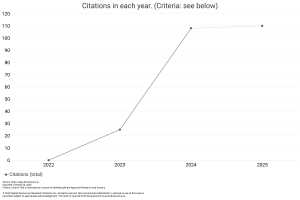Analysis of Independent Practice Midwifes in West Pasaman District Using Partograph in Normal Delivery Care
DOI:
https://doi.org/10.59653/ijmars.v2i03.895Keywords:
Partograph, Midwife, Independent Practice MidwivesAbstract
The maternal mortality rate (MMR) and infant mortality rate (IMR) are key performance indicators for a nation. For every Indonesian population, MMR and IMR represent one of the parameters of optimal health status. In an effort to lower the MMR, health professionals are urged to use Partograph to track the progress of labor and make appropriate decisions if pathological conditions are discovered. It has been demonstrated that the Partograph works well for both identifying irregularities in labor and preventing prolonged labor. The purpose of the study is to find out how Partograph are used by midwives at the Independent Midwife Practice in the West Pasaman district. Since the informants for this research are independent practice midwives, the qualitative descriptive research method will be used to collect data through focus group discussions (FGD), in-depth interviews, and observations. Data analysis: By deciphering, writing up, and drawing conclusions from in-depth interviews conducted with key informants and two discussion groups. The research's conclusions are based on the findings of two focus groups and two key informant interviews. Specifically, Partograph are used by independent practice midwives to aid in childbirth; some midwives have also used them to track the progression of labor, particularly for patients with birth insurance so they can claim delivery expenses. The Partograph is filled all the way, but occasionally it is filled after delivery. The only reason partography is applied is to obtain Jampersal fees; independent practical midwives are knowledgeable about partography and have a positive attitude toward it. Organizational policies and leadership for IBI are still lacking.
Downloads
References
Anak Agung Ngurah Anantasika, I Wayan Artana Putra, Ida Bagus Putra Adnyana, I Wayan Megadhana, Ryan Saktika Mulyana, & Hariyanto, A. D. (2023). Friedman Curve Positively Correlates with Cesarean Section and Oxytocin Augmentation in Active Phase Delivery as Compared to Partograph. Indonesian Journal of Obstetrics and Gynecology, 11(3), 143–147. https://doi.org/10.32771/inajog.v11i3.1867
Ayenew, A. A., & Zewdu, B. F. (2020). Partograph utilization as a decision-making tool and associated factors among obstetric care providers in Ethiopia: a systematic review and meta-analysis. Systematic Reviews, 9(1), 1–11. https://doi.org/10.1186/s13643-020-01505-4
Azhar, Z. (2023). Making Applications for Midwives’ Independent Practice Using the Waterfall Method. Journal of Health Science and Medical Therapy, 1(01), 30–37. https://doi.org/10.59653/jhsmt.v1i01.144
Bosse, G., Massawe, S., & Jahn, A. (2002). The partograph in daily practice: It’s quality that matters. International Journal of Gynecology and Obstetrics, 77(3), 243–244. https://doi.org/10.1016/S0020-7292(02)00004-8
Fawole, A. O., Hunyinbo, K. I., & Adekanle, D. A. (2008). Knowledge and utilization of the partograph among obstetric care givers in south west Nigeria. African Journal of Reproductive Health, 12(1), 22–29. https://doi.org/10.2307/25470629
Gans-Lartey, F., O’Brien, B. A., Gyekye, F. O., & Schopflocher, D. (2013). The relationship between the use of the partograph and birth outcomes at Korle-Bu teaching hospital. Midwifery, 29(5), 461–467. https://doi.org/10.1016/j.midw.2012.03.002
Laksmi, N. P. C. (2023). Relationship between Husband’s Social Support and Participation in Pregnant Women Class in Denpasar City in 2019. Journal of Health Science and Medical Therapy, 2(01 SE-Articles), 63–69. https://doi.org/10.59653/jhsmt.v2i01.444
N, J., & Thayumanavan, M. (2023). Utilization of Partograph for Labor Management Among Healthcare Providers in Healthcare Facilities in India: A Systematic Review. Cureus, 15(8). https://doi.org/10.7759/cureus.44242
Ollerhead, E., & Osrin, D. (2014). 25132124. 1–7.
Rahman, A., Begum, T., Ashraf, F., Akhter, S., Hoque, D. M. E., Ghosh, T. K., Rahman, M., Stekelenburg, J., Das, S. K., Fatima, P., & Anwar, I. (2019). Feasibility and effectiveness of electronic vs. paper partograph on improving birth outcomes: A prospective crossover study design. PLoS ONE, 14(10), 1–15. https://doi.org/10.1371/journal.pone.0222314
Sanghvi, H., Mohan, D., Litwin, L., Bazant, E., Gomez, P., MacDowell, T., Onsase, L., Wabwile, V., Waka, C., Qureshi, Z., Omanga, E., Gichangi, A., & Muia, R. (2019). Effectiveness of an Electronic Partogram: A Mixed-Method, Quasi-Experimental Study Among Skilled Birth Attendants in Kenya. Global Health Science and Practice, 7(4), 521–539. https://doi.org/10.9745/GHSP-D-19-00195
Sidik, M., & Kusrini. (2015). Aplikasi Partograf Sebagai Media Bantu Dalam Proses Persalinan Di Rumah Sakit Ibu Dan Anak Arvita Bunda Yogyakarta. Jurnal Dasi, 13(2), 44–49.
Siswanto, A. (2023). Pengaruh Penggunaan Partograf Digital dan Manual terhadap Pengambilan Keputusan Bidan dalam Proses Persalinan Dimasa Pandemi Rangkasbitung Tahun 2021. Indonesia Journal of Midwifery Sciences, 2(3), 275–282. https://doi.org/10.53801/ijms.v2i3.118
Tina Lavender, D., Omoni, G., Lee, K., Wakasiaki, S., Campbell, M., Watiti, J., & Mathai, M. (2013). A pilot quasi-experimental study to determine the feasibility of implementing a partograph e-learning tool for student midwife training in Nairobi. Midwifery, 29(8), 876–884. https://doi.org/10.1016/J.MIDW.2012.10.003
Wahyuni, S., Nuryuniarti, R., & Nurmahmudah, E. (2019). A Design of Partograph Mobile with Android Based to Monitoring Childbirth Process. Journal of Physics: Conference Series, 1179(1). https://doi.org/10.1088/1742-6596/1179/1/012157
Downloads
Published
How to Cite
Issue
Section
Categories
License
Copyright (c) 2024 Timmy Larasati, Ratna Dewi

This work is licensed under a Creative Commons Attribution-ShareAlike 4.0 International License.
Authors who publish with this journal agree to the following terms:
- Authors retain copyright and grant the journal right of first publication with the work simultaneously licensed under a Creative Commons Attribution-ShareAlike that allows others to share the work with an acknowledgement of the work's authorship and initial publication in this journal.
- Authors are able to enter into separate, additional contractual arrangements for the non-exclusive distribution of the journal's published version of the work (e.g., post it to an institutional repository or publish it in a book), with an acknowledgement of its initial publication in this journal.
- Authors are permitted and encouraged to post their work online (e.g., in institutional repositories or on their website) prior to and during the submission process, as it can lead to productive exchanges, as well as earlier and greater citation of published work (See The Effect of Open Access).
























